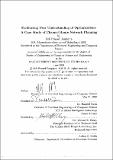| dc.contributor.advisor | Randall Davis. | en_US |
| dc.contributor.author | Dasgupta, Deb Prasad, 1980- | en_US |
| dc.contributor.other | Massachusetts Institute of Technology. Dept. of Electrical Engineering and Computer Science. | en_US |
| dc.date.accessioned | 2005-05-19T15:27:38Z | |
| dc.date.available | 2005-05-19T15:27:38Z | |
| dc.date.copyright | 2003 | en_US |
| dc.date.issued | 2003 | en_US |
| dc.identifier.uri | http://hdl.handle.net/1721.1/16962 | |
| dc.description | Thesis (M.Eng.)--Massachusetts Institute of Technology, Dept. of Electrical Engineering and Computer Science, 2003. | en_US |
| dc.description | Includes bibliographical references (p. 145-146) and index. | en_US |
| dc.description | This electronic version was submitted by the student author. The certified thesis is available in the Institute Archives and Special Collections. | en_US |
| dc.description.abstract | As more complex and important tasks become automated, the human-system interface is becoming more prominent. It is necessary for users to trust the systems performing these tasks; otherwise, they are unlikely to use the system. Automated planning is one such task. An integral part of planning systems using an Operations Research approach is the use of optimization techniques to create plans. In problems of realistic size, the solution process of the optimization is too complex to follow in detail, so it is not possible for the user to evaluate the effectiveness of the solution. For instance, the Channel Route Network Planning System uses an optimization to create plans for the shipment of cargo between military bases around the world. Although it chooses the optimal plan for a given set of inputs, its users could plan more effectively if they better understood the underlying decision space of its optimization and had ready access to the details of the plans it generates. This thesis presents ChRIS, the Channel Route Information System. ChRIS is designed to enable users to gain insight into plans developed by results of the Channel Route Network Planning System. It helps users understand the internal structure of the individual plans and illustrates the differences between multiple plans, thereby helping users to understand the optimization, which we believe will engender trust in the system's choice of optimal plans. | en_US |
| dc.description.statementofresponsibility | by Deb Prasad Dasgupta. | en_US |
| dc.format.extent | 149 p. | en_US |
| dc.format.extent | 3092752 bytes | |
| dc.format.extent | 3131484 bytes | |
| dc.format.mimetype | application/pdf | |
| dc.format.mimetype | application/pdf | |
| dc.language.iso | eng | en_US |
| dc.publisher | Massachusetts Institute of Technology | en_US |
| dc.rights | M.I.T. theses are protected by copyright. They may be viewed from this source for any purpose, but reproduction or distribution in any format is prohibited without written permission. See provided URL for inquiries about permission. | en_US |
| dc.rights.uri | http://dspace.mit.edu/handle/1721.1/7582 | |
| dc.subject | Electrical Engineering and Computer Science. | en_US |
| dc.title | Facilitating user understanding of optimizations : a case study of channel route network planning | en_US |
| dc.type | Thesis | en_US |
| dc.description.degree | M.Eng. | en_US |
| dc.contributor.department | Massachusetts Institute of Technology. Department of Electrical Engineering and Computer Science | |
| dc.identifier.oclc | 53439612 | en_US |
